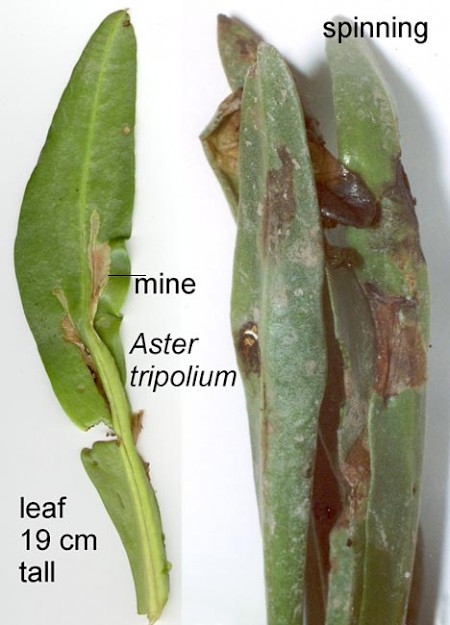Scrobipalpa salinella

(B19) BF813
Scrobipalpa salinella
(Zeller, 1847)
Wingspan 11-15 mm.
Scrobipalpa salinella is found on saltings in England and Wales where its foodplants, sea-blite, sea aster and glasswort, grow. It flies June - September. It is regarded as a local and difficult-to-record species (MBGBI 4-2), and can probably be most easily found by searching for larvae from late April to early June. Certainly, larvae were common in May 2004 on the Dee Estuary in Flintshire and Cheshire, two counties where it had not been previously recorded. The larvae can live on plants on the lowest parts of saltings, which are frequently immersed by the tide.
Worn adult specimens of Scrobipalpa species, without known foodplant associations, are easily confused and require examination of the genitalia.
Larva: (description Ian F. Smith)
Foodplant:
April - June on spun leaves of Suaeda maritima, and in mines and spinnings on Aster tripolium and annual Salicornia. The larva can make a series of mines and spinnings. On Aster the mines of different larvae may coalesce. In May, 2cm seedlings of Salicornia and Suaeda growing on bare mud on the outer edge of saltings are used. Salicornia is stated (MBGBI 4-2) to be the regular foodplant, but the larvae are easiest to find in Aster tripolium. Larvae from Salicornia, when put on pre-sewn Salicornia seedlings, transferred themselves immediately onto the few stray seedlings of Suaeda growing in the same pot.
Larvae (7mm - 11 mm) found on spun Salicornia in August may have been a second generation, or have had their development retarded by the parasitoids they contained.
Other recorded foodplants (MBGBI 4-2) are Spergularia spp. And Limonium vulgare.
Length: 13 mm and 14 mm described. (Variation of 6 mm and 7 mm larvae in brackets).
Head: (6-7 mm, pitchy black) Brown with a few darker brown marks on epicranial lobe. Posterior and frons thinly edged black. Large black postero-lateral mark. Stemmatal area blackish. Mouthparts dark reddish brown with white clypeus.
Prothoracic shield: Shiny black. Divided by whitish medial line. (6-7mm, line less distinct).
Thoracic legs: Black with whitish joints.
Body: Ground colour greenish yellow (6-7mm, yellowish) predominates ventrally and intersegmentally. Brick red dorsal line formed by contractile dorsal vessel and integument pigment. Dorsal line weaker at anterior (6-7 mm, stronger red, but indistinct on thorax).
Each segment has extensive reddish pigment laterally, which on 14 mm larvae is least intense on the thorax.
Spiracles: Peritreme dark brown (6-7 mm, brown).
Pinacula: Small, largest on A9. Consisting of black setal spot with a narrow grey sclerotised periphery. Pinacula encircled by disc of integument slightly paler than ground colour. (6-7 mm, disc proportionally larger).
Setae: Translucent grey.
Anal plate: Blotchy black and brownish black. Glossy. (6-7 mm, grey with black spots).
Prolegs: Coloured as venter. Crochets pitchy black.
Similar species:
Bucculatrix maritima has similar, but usually smaller, mines in Aster tripolium.Its larvae lack reddish markings.
Scrobipalpa suaedella on Suaeda maritima has similar larvae, but the head remains black when full grown (MBGBI 4-2). It is apparently restricted to the coast of South East England.
Scrobipalpa nitentella on Suaeda maritima is at the larval stage in September - October. It has a paler anterior and a less distinct dorsal line.
When in doubt, Scrobipalpa spp. should be reared and the genitalia examined, aided by MBGBI 4-2.

 UKMoths
UKMoths 








